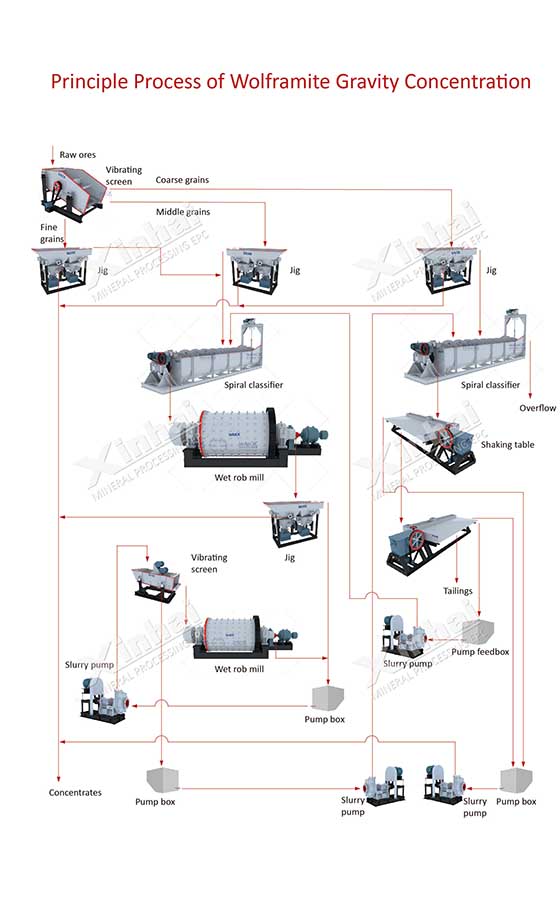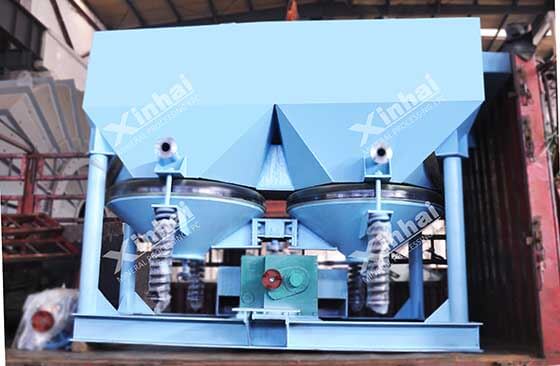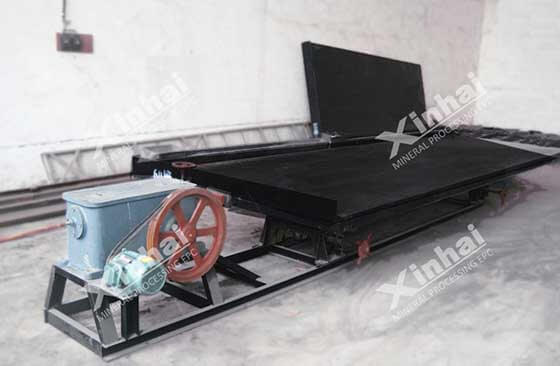

Warm Tip: If you want to know more details about equipment, solutions, etc, please click the button below for free consultation, or leave your requirements!
Wolframite ore is characterized by low grade of raw ore, high dilution rate of ore mining, and complex mineral composition, which brings difficulties to separation.
For wolframite or wolframite-based ores, the beneficiation process generally consists of the following parts:
1. Crush and discard waste in advance to obtain qualified ore;
2. Use gravity separation to discard tailings to obtain coarse concentrate;
3. Separation and comprehensive recovery of coarse concentrate to obtain the final concentrate;
4. Fine mud treatment.
Click here to see details of tungsten processing.
The principle process of gravity separation adopted is generally: one to two stages of grinding, three stages of jigging, four to five stages of shaking table, and concentrated treatment of fine mud to obtain coarse concentrate and discard a large amount of tailings. The coarse and medium-grain jigging tailings are fed into the rod mill for regrind, and the grinding products are returned to the double-layer vibrating screen, thus forming a closed loop circuit.
We often use two stages of shaking table separation, the coarse and medium-grain middling of shaking table return to the circulation loop, and the mud is treated separately.
The grade of WO3 for the gravity separation section (qualified ore which discarded waste in advance) is generally 0.4%-0.8%, the grade of WO3 for coarse concentrate is generally 20%-30%, and the grade of tailings is generally 0.03%-0.056%. The recovery rate is 90%-94%, and the yield of discarded tailings is 45%-55%.

Principle Process of Wolframite Gravity Concentration
Hand picking is a simple method of pre-enrichment before gravity separation, and it is also a necessary operation in the process flow of wolframite beneficiation. Picking the waste rock from the raw ore is called the reverse hand picking, and picking the qualified tungsten ore from the raw ore is called the direct hand picking.
Depending on the nature of the ore, some concentrators use reverse hand picking at all levels, while some concentrators use a process that combines reverse and direct hand picking.
Because tungsten is brittle and has a high specific gravity, it is easy to be over-ground during the grinding process, and to produce too much secondary mud. The gravity separation operation has limitations on the fine-grained recovery, so the grinding process in the tungsten ore separation is especially important.
Therefore, the grinding of wolframite generally use rod mills, which can not only avoid over-grinding, and but also can ensure that the particle size of the grinding product is relatively uniform, and meet the requirements of particle size in gravity separation.
Jig is important gravity separation equipment in the wolframite concentrator.Generally wolframite separation uses three-stage jigging, which is screening all qualified ore into three levels of coarse, medium and fine to enter the jigging operation.The upper limit of particle size in the coarse-grained jigging is 13mm, generally 8mm-10mm, and the particle size range of the medium-grained jigging process is 1.5-5mm.
The coarse and medium-grain jigging tailings are reground and re-separated, and the recovery rate of the coarse and medium-grain jigging operation can reach 65%-75%. The fine-grained jig tailings are sorted by a shaking table after being hydraulically classified, and the shaking table operation discards the tailings.
The recovery rate of fine-grain jigs is low, mainly because there are some materials that are difficult to recover by jig separation (-0.074mm part). Because all the grains less than 2mm (or 1.5mm) would be processed by jigging, the fine-grained tungsten metal would be lost in the tailings.
If the -0.5mm part of the selected material is pre-screened with a high-frequency vibrating screen, it will not only reduce the amount of materials in fine-grained jigging, but also increase Its operating recovery rate.
The concentrate from the roughing jigging operation is sent to the beneficiation operation as the coarse concentrate of the gravity separation section by most concentrators.

Jig
Shaking table is one of the most common gravity separation equipment used in the separation of medium and fine-grained ores, and the suitable particle size is 0.037-2mm.
Advantages of shaking table:
(1) High enrichment ratio (up to hundreds of times);
(2) After one-time separation, high-grade concentrate and discarded tailings can be obtained;
(3) Multiple products can be received at the same time;
(4) Minerals with different densities are clearly zoning on the bed surface, which is easy to receive.
Disadvantages of shaking table:
(1) Low processing capacity;
(2) It occupies a large area of the plant.
Large concentrators often use shaking table as concentrating equipment, while small concentrators can directly use it as roughing and concentrating equipment.

Shaking Table
Before entering the shaking table, the incoming material should be classified into a narrower size.
According to the particle size of the processed materials, the shaking table can be classified in to: Coarse sand shaking table, processing particle size is 3 (2) ~ 0.5 (0.2) mm;
Fine sand shaking table, processing particle size is 0.5 (0.2) ~ 0.074 mm;
Mud shaking table, processing particle size is 0.074~0.037 mm.
According to the nature of the operation, the shaking table can be divided into roughing shaking table and concentrating shaking table.
Production practice has proved that the 6-S shaking table is better for processing coarse-grained materials (-2+0.2mm), and the Yunxi shaking table is better for fine-grained materials (-0.2mm).
The table surface of the shaking table includes lacquer surface, rubber surface, and glass fiber reinforced plastic surface. When the material of the surface is different, the friction force generated by the movement of the mineral particles is also different.
The production practice has proved that the separation effect of glass fiber reinforced plastic surface is better than that of Chinese fir rubber surface.
In order to ensure a good gravity separation effect, the narrower the particle size range of each gravity separation operation, the better. So before using shaking table, we should do pre-classification of the ore. The commonly used classifying machine in tungsten concentrators is hydraulic classification box, which is also commonly used classifying equipment in gravity separation concentrators.
The hydraulic classification box can be divided into two types: stirring type and stirring type, generally 4-6 chambers.
The classification efficiency of the hydraulic classification box is not high. The main reason is that the rising water velocity of each section is not uniform. Affected by the change of water pressure, the rising water velocity of each chamber will also change, plus factors such as the clogging of the spigot, the amount of ore and the changes in the concentration of the ore will make the classification efficiency worse.
In view of the low classification efficiency and large fluctuations of the hydraulic classification box, many tungsten concentrators currently use high-frequency vibrating screens for classification. Some tungsten concentrators will also apply high-frequency vibrating screens to the grinding and classification circuit. First, it can improve the classification efficiency. Second, it can make the ore be classified strictly according to the geometric size, which can avoid the situation that the materials with large specific gravity and particle size go back to grinding process and be over-ground when using spiral classifier and hydrocyclone.
In actual beneficiation, you can refer to the above-mentioned focus to select suitable equipment for the rough separation of wolframite, but the guidance of professional beneficiation technicians and beneficiation tests are also necessary.
If you have any questions about the above content, please leave a message on the website or communicate directly with online customer service.
Last: What Factors Will Influence Ball Mill Grinding Efficiency?


What Are the Differences Between CIP and CIL?
 11336
11336
 0
0